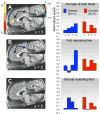Increased anterior cingulate cortical activity in response to fearful faces: a neurophysiological biomarker that predicts rapid antidepressant response to ketamine
- PMID: 18822408
- PMCID: PMC2643469
- DOI: 10.1016/j.biopsych.2008.08.014
Increased anterior cingulate cortical activity in response to fearful faces: a neurophysiological biomarker that predicts rapid antidepressant response to ketamine
Abstract
Background: Most patients with major depressive disorder (MDD) experience a period of lengthy trial and error when trying to find optimal antidepressant treatment; identifying biomarkers that could predict response to antidepressant treatment would be of enormous benefit. We tested the hypothesis that pretreatment anterior cingulate cortex (ACC) activity could be a putative biomarker of rapid antidepressant response to ketamine, in line with previous findings that investigated the effects of conventional antidepressants. We also investigated patterns of ACC activity to rapid presentation of fearful faces compared with the normal habituation observed in healthy subjects.
Methods: We elicited ACC activity in drug-free patients with MDD (n = 11) and healthy control subjects (n = 11) by rapidly presenting fearful faces, a paradigm known to activate rostral regions of the ACC. Spatial-filtering analyses were performed on magnetoencephalographic (MEG) recordings, which offer the temporal precision necessary to estimate ACC activity elicited by the rapid presentation of stimuli. Magnetoencephalographic recordings were obtained only once for both patients and control subjects. Patients were subsequently administered a single ketamine infusion followed by assessment of depressive symptoms 4 hours later.
Results: Although healthy subjects had decreased neuromagnetic activity in the rostral ACC across repeated exposures, patients with MDD showed robust increases in pretreatment ACC activity. Notably, this increase was positively correlated with subsequent rapid antidepressant response to ketamine. Exploratory analyses showed that pretreatment amygdala activity was negatively correlated with change in depressive symptoms.
Conclusions: Pretreatment rostral ACC activation may be a useful biomarker that identifies a subgroup of patients who will respond favorably to ketamine's antidepressant effects.
Figures



Similar articles
-
Anterior cingulate desynchronization and functional connectivity with the amygdala during a working memory task predict rapid antidepressant response to ketamine.Neuropsychopharmacology. 2010 Jun;35(7):1415-22. doi: 10.1038/npp.2010.24. Epub 2010 Mar 10. Neuropsychopharmacology. 2010. PMID: 20393460 Free PMC article.
-
Comparing the actions of lanicemine and ketamine in depression: key role of the anterior cingulate.Eur Neuropsychopharmacol. 2016 Jun;26(6):994-1003. doi: 10.1016/j.euroneuro.2016.03.006. Epub 2016 Apr 28. Eur Neuropsychopharmacol. 2016. PMID: 27133029 Clinical Trial.
-
Ketamine Alters Electrophysiological Responses to Emotional Faces in Major Depressive Disorder.J Affect Disord. 2021 Jan 15;279:239-249. doi: 10.1016/j.jad.2020.10.007. Epub 2020 Oct 7. J Affect Disord. 2021. PMID: 33074143 Free PMC article. Clinical Trial.
-
Effect of ketamine on task-based functional magnetic resonance imaging findings in major depressive disorder: A mini-review.J Affect Disord. 2025 Feb 1;370:181-189. doi: 10.1016/j.jad.2024.10.118. Epub 2024 Nov 2. J Affect Disord. 2025. PMID: 39489183 Review.
-
The anterior cingulate cortex as a key locus of ketamine's antidepressant action.Neurosci Biobehav Rev. 2021 Aug;127:531-554. doi: 10.1016/j.neubiorev.2021.05.003. Epub 2021 May 11. Neurosci Biobehav Rev. 2021. PMID: 33984391 Review.
Cited by
-
Serial Prefrontal Pathways Are Positioned to Balance Cognition and Emotion in Primates.J Neurosci. 2020 Oct 21;40(43):8306-8328. doi: 10.1523/JNEUROSCI.0860-20.2020. Epub 2020 Sep 28. J Neurosci. 2020. PMID: 32989097 Free PMC article.
-
Functional Dysconnectivity of Frontal Cortex to Striatum Predicts Ketamine Infusion Response in Treatment-Resistant Depression.Int J Neuropsychopharmacol. 2020 Dec 29;23(12):791-798. doi: 10.1093/ijnp/pyaa056. Int J Neuropsychopharmacol. 2020. PMID: 32726408 Free PMC article. Clinical Trial.
-
Ameliorating treatment-refractory depression with intranasal ketamine: potential NMDA receptor actions in the pain circuitry representing mental anguish.CNS Spectr. 2016 Feb;21(1):12-22. doi: 10.1017/S1092852914000686. Epub 2015 Jan 26. CNS Spectr. 2016. PMID: 25619798 Free PMC article. Review.
-
Of mice and men: bridging the translational disconnect in CNS drug discovery.CNS Drugs. 2009 Nov;23(11):915-26. doi: 10.2165/11310890-000000000-00000. CNS Drugs. 2009. PMID: 19845413
-
EEG power asymmetry and functional connectivity as a marker of treatment effectiveness in DBS surgery for depression.Neuropsychopharmacology. 2014 Apr;39(5):1270-81. doi: 10.1038/npp.2013.330. Epub 2013 Nov 28. Neuropsychopharmacology. 2014. PMID: 24285211 Free PMC article.
References
-
- Davidson RJ, Irwin W, Anderle MJ, Kalin NH. The neural substrates of affective processing in depressed patients treated with venlafaxine. Am J Psychiatry. 2003;160:64–75. - PubMed
-
- Mayberg HS, Brannan SK, Mahurin RK, Jerabek PA, Brickman JS, Tekell JL, et al. Cingulate function in depression: a potential predictor of treatment response. Neuroreport. 1997;8:1057–1061. - PubMed
-
- Saxena S, Brody AL, Ho ML, Zohrabi N, Maidment KM, Baxter LRJ. Differential brain metabolic predictors of response to paroxetine in obsessive-compulsive disorder versus major depression. Am J Psychiatry. 2003;160:522–532. - PubMed
-
- Trivedi MH, Rush AJ, Wisniewski SR, Nierenberg AA, Warden D, Ritz L, et al. Evaluation of outcomes with citalopram for depression using measurement-based care in STAR*D: implications for clinical practice. Am J Psychiatry. 2006;163:28–40. - PubMed
-
- Berman RM, Cappiello A, Anand A, Oren DA, Heninger GR, Charney DS, et al. Antidepressant effects of ketamine in depressed patients. Biol Psychiatry. 2000;47:351–354. - PubMed
Publication types
MeSH terms
Substances
Grants and funding
LinkOut - more resources
Full Text Sources
Other Literature Sources
Medical

